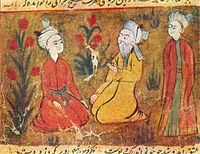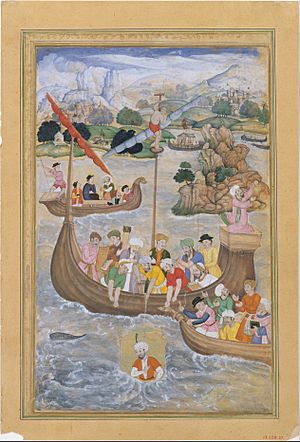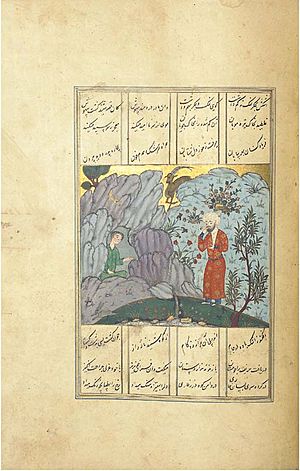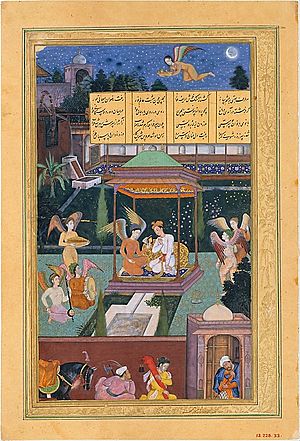Amir Khusrau facts for kids
Quick facts for kids
Amir Khusrau
|
|
|---|---|

Amir Khusrow teaching his disciples in a miniature from a manuscript of Majlis al-Ushshaq by Husayn Bayqarah.
|
|
| Background information | |
| Birth name | Ab'ul Hasan Yamīn ud-Dīn K͟husrau |
| Born | 1253 Patiyali, Delhi Sultanate (now in Uttar Pradesh, India) |
| Died | October 1325 (aged 71–72) Delhi, Delhi Sultanate (now in Delhi, India) |
| Genres | Ghazal, Qawwali, Ruba'i, Tarana |
| Occupation(s) | Sufi, singer, poet, composer, author, scholar |
| Influenced by Nizamuddin Auliya | |
Amir Khusrau (born 1253, died 1325) was a very famous poet, musician, and scholar from India. He lived during the time of the Delhi Sultanate, which was a powerful kingdom in India. Many people call him the "voice of India" or "Parrot of India" (Tuti-e-Hind) because of his amazing talent with words. He is also known as the "father of Urdu literature".
Khusrau was a Sufi mystic, which means he followed a spiritual path in Islam focused on inner peace and love. He was a student of Nizamuddin Auliya, a respected Sufi saint in Delhi. Khusrau wrote most of his poems in Persian, but he also wrote in Hindavi, an early form of Hindi and Urdu. He is also known for creating qawwali, a special type of devotional singing, and for bringing the ghazal style of poetry to India. Both qawwali and ghazal are still very popular today.
Contents
Amir Khusrau's Family and Childhood
Amir Khusrau was born in 1253 in a place called Patiyali in modern-day Uttar Pradesh, India. His father, Amir Saif ud-Dīn Mahmūd, came from a Turkic family. His mother, Bibi Daulat Naz, was Indian.
His father's family had to leave their home in Central Asia because of Genghis Khan's invasions. They traveled to Balkh (now in Afghanistan) and then asked the Sultan of Delhi for help. The Sultan, Shams-ud-din Iltutmish, welcomed them. In 1230, Khusrau's father was given a piece of land in Patiyali.
Khusrau's mother, Bibi Daulat Naz, was the daughter of Rawat Arz, an Indian noble who worked for Ghiyas ud din Balban, another Sultan of Delhi. Her family belonged to the Rajput community.
Early Years and Learning
Amir Khusrau had three brothers and one sister. Sadly, his father died in 1260 when Khusrau was only eight years old. From his father, he learned about Islam and Sufism. He also became very good at Turkish, Persian, and Arabic languages.
Khusrau was a very smart child. He started writing poetry when he was just nine years old. His first collection of poems, called Tuhfat us-Sighr (The Gift of Childhood), was put together in 1271. These poems were written when he was between 16 and 18 years old. In 1273, when Khusrau was 20, his grandfather passed away.
Amir Khusrau's Career
After his grandfather's death, Khusrau began working for Malik Chajju, who was a relative of the Sultan, Ghiyas ud din Balban. This helped his poetry become known in the royal court, where he was highly praised.
Later, Nasiruddin Bughra Khan, the Sultan's son, was very impressed by Khusrau's work and became his supporter in 1276. Khusrau traveled with different rulers and nobles, writing poems and stories. He wrote his second collection of poems, Wast ul-Hayat (The Middle of Life), in 1279.
Khusrau also went to Multan in 1281 with Khan Muhammad, the Sultan's eldest son. Multan was an important city for learning and trade at that time. Sadly, Khan Muhammad was killed in a battle against the Mongols in 1285. Khusrau wrote two sad poems about his death.
After Sultan Balban died, his grandson Muiz ud din Qaiqabad became the new Sultan. Khusrau worked for him for two years. During this time, he finished his first long poem, a masnavi called Qiran us-Sa'dain (Meeting of the Two Auspicious Stars). This poem was about the meeting between Bughra Khan and his son Qaiqabad after a long disagreement.
When a new ruler, Jalal-ud-din Khalji, took over in 1290, he also loved poetry. Khusrau was given the title "Amir" and was highly respected in his court. Khusrau's poems were even set to music and sung for the Sultan every night. In 1290, Khusrau finished another masnavi, Miftah ul-Futuh (Key to the Victories), praising Jalal ud-Din Firuz's wins.

Working for Ala ud-Din Khalji
In 1296, Ala-ud-din Khalji became the Sultan. Khusrau wrote a book called Khaza'in ul-Futuh (The Treasures of Victory) about Ala ud-Din's building projects, wars, and how he managed the kingdom. He also wrote a famous collection of five long poems called Khamsa-e-Khusrau (Khamsa of Khusrau) in 1298. These poems were inspired by an earlier Persian poet named Nizami Ganjavi. One of these poems, Aina-e-Sikandari, told the heroic stories of Alexander the Great. Another, Hasht-Bihisht, was based on legends about a Persian king. These works made Khusrau a very important poet.
In 1300, Khusrau faced personal sadness when his mother and brother died. He wrote these lines:
A double radiance left my star this year
Gone are my brother and my mother,
My two full moons have set and ceased to shine
In one short week through this ill-luck of mine.
Spiritual Journey and Later Works
In 1310, Khusrau became a student of the Sufi saint Nizamuddin Auliya. This was a very important part of his life. In 1315, he finished a romantic masnavi called Duval Rani - Khizr Khan, which was a love story.
After Ala ud-Din Khalji died, his son Qutb ud din Mubarak Shah became Sultan. Khusrau wrote a masnavi called Nuh Sipihr (Nine Skies) about his reign. In this book, he wrote a detailed and beautiful description of India, its nature, seasons, and cultures. He also wrote Ijaz-e-Khusravi (The Miracles of Khusrau), a collection of prose.
In 1320, a new ruler, Ghiyath al-Din Tughlaq, started the Tughlaq dynasty. Khusrau began writing a historical masnavi called Tughlaq Nama (Book of the Tughlaqs) about this new dynasty.
Amir Khusrau died in October 1325, just six months after his spiritual teacher, Nizamuddin Auliya. His tomb is located next to his master's in the Nizamuddin Dargah in Delhi.
Amir Khusrau's Contributions to Music
Khusrau is famous for his contributions to Indian music.
Qawwali
Khusrau is often called the "father of qawwali". He combined different music styles from Persia, Arabia, Turkey, and India to create this special type of Sufi devotional singing. Qawwali songs have a strong chorus and a lead singer who uses fast and complex musical patterns.
Tarana and Trivat
Khusrau is also believed to have invented the Tarana and Trivat styles of music. It is said that he created the tarana style by listening to another musician and then recreating the sounds using rhythmic words.
Sitar
Many people believe that Khusrau invented the sitar, a popular stringed instrument. At that time, there were many types of Veena (an ancient Indian instrument). Khusrau took a three-stringed Tritantri Veena and renamed it Setar (which means "three-stringed" in Persian). Over time, this instrument became known as the sitar.
Amir Khusrau's Legacy
Amir Khusrau was a very productive poet who worked for many rulers of the Delhi Sultanate. He wrote many fun riddles, songs, and stories that are still popular in South Asia today. His riddles, which often use wordplay, are one of the most loved forms of Hindavi poetry. These riddles have been passed down by word of mouth for over 700 years.
Khusrau is seen as one of the first Indian figures who truly represented a mix of different cultures. Musicians also credit him with creating several music styles, including qaul, qalbana, naqsh, gul, tarana, and khyal.
Development of Hindavi
While Khusrau mainly wrote in Persian, many Hindavi verses are linked to him. He also wrote a war song in Punjabi. He could speak Arabic and Sanskrit too. His poetry is still sung at Sufi shrines across India and Pakistan.
Amir Khusrau's Works
- Tuhfat us-Sighr (The Gift of Childhood), 1271: His first collection of poems, written when he was a teenager.
- Wast ul-Hayat (The Middle of Life), 1279: His second collection of poems.
- Qiran us-Sa’dain (Meeting of the Two Auspicious Stars), 1289: His first long poem, about a historic meeting.
- Miftah ul-Futuh (Key to the Victories), 1290: A long poem praising a Sultan's victories.
- Ghurrat ul-Kamaal (The Prime of Perfection), 1294: Poems written when he was in his thirties.
- Khaza'in ul-Futuh (The Treasures of Victories), 1296: Details about a Sultan's projects and wars.
- Khamsa-e-Khusrau (Khamsa of Khusrau), 1298: A collection of five long poems, including stories like Laila-Majnun and the adventures of Alexander the Great.
- Duval Rani - Khizr Khan (Duval Rani and Khizr Khan), 1316: A sad love story.
- Nuh Sipihr (Nine Skies), 1318: A long poem about a Sultan's rule, with beautiful descriptions of India.
- Ijaz-e-Khusravi (The Miracles of Khusrau): A collection of his writings in prose.
- Afzal ul-Fawaid (Greatest of Blessings), 1319: A book containing the teachings of his spiritual master, Nizamuddin Auliya.
- Tughlaq Nama (Book of the Tughlaqs), 1320: A historical long poem about the Tughlaq dynasty.
- Nihayat ul-Kamaal (The Zenith of Perfection), 1325: His last collection of poems, put together shortly before his death.
- Ashiqa: A long poem that praises the Hindi language and tells the story of Deval Devi.
- Qissa Chahar Dervesh (The Tale of the Four Dervishes): A story he told to Nizamuddin Auliya.
- Ḳhāliq Bārī: A dictionary in verse, often said to be by Khusrau, containing Persian, Arabic, and Hindavi words.
See also
 In Spanish: Jursan Amir para niños
In Spanish: Jursan Amir para niños
- Chhaap Tilak Sab Chheeni
- Man Kunto Maula
- Dama Dam Mast Qalandar
- Jahan-e-Khusrau
- Indian literature
- List of Persian poets and authors
- Khamsa of Nizami
- Haft Peykar





